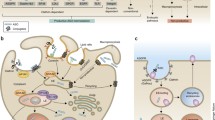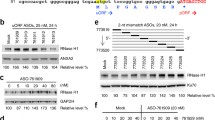Abstract
Antisense oligonucleotide represents an interesting tool for selective inhibition of gene expression. However, their low efficiency of introduction within intact cells remains to be overcome. Antisense-TGFβ (25 mer) and antisense-TNFα (18 mer) were used to study the cellular transport and biological function of antisense oligonucleotide in vitro. Since TGF and TNF play on important role in regulating the nitric oxide production from macrophages, the action of the above antisense oligonucleotides was easily monitored by the determination of nitrite. Poly-L-lysine, benzalkonium chloride and tetraphenylphosphonium chloride were used as polycations, which neutralize the negative charge of antisense oligonucleotide. The production of nitric oxide mediated by γ-IFN in mouse peritoneal macrophage was increased by antisense-TGFβ in a dose-dependent manner. Antisense-TNFα reduced the nitric oxide release from activated RAW 264.7 cells. Significant enhancement in the nitric oxide production was investigated by the cotreatment of poly-L-lysine with antisense-TGFβ. On the meanwhile, inhibition effect of antisense-TNFα is not changed by the addition of poly-L-lysine. These results demonstrate that control of expression of TGFβ and TNFα gene is achieved using antisense technology and the cellular uptake of antisense oligonucleotide could be enhanced by ion-pairing.
Similar content being viewed by others
References Cited
Agrawal, S., Goodchild, J. and Civeira, M. P., Oligode-oxynucleoside phosphoramidates and phosphorothioates as inhibitors of human immunodeficiency virus.Proc. Natl. Acad. Sci. USA, 85, 7079–7083 (1988).
Agrawal, S., Temsamani, J. and Tang, J. Y., Pharmacokinetics, biodistribution, and stability of oligonucleotide phosphorothioates in mice.Proc. Natl. Acad. Sci. USA, 88, 7595–7599 (1991).
Akhtar, S. and Shoji, Y., Degradation and membrane transport characteristics of modified antisense oligonucleotides.J. Cell. Biochem., 15D, 16 (1991).
Aselline, U. and Toulme, F., Oligodeoxynucleotides covalently linked to intercalating dyes to base sequence-specific ligands. Influence of dye attachment site.EMBO J., 3, 795–800 (1984).
Chavany, C., Doan, T. L., Courvreur, P., Polyalkylcyanoacrylatenamopartcles as polymeric carriers for antisense oligonucleotides.Pharmaceutical Res., 9, 441–449 (1992).
Eckstein, F., Nucleoside phosphorothioates.Ann. Rev. Biochem., 54, 267–402 (1985).
Gao, W.-Y., Hanes, R. N., and Miguel, A., Vanzquez-Padua, Inhibition of Herpes Simplex Virus Type 2 growth by phosphorothioate oligodeoxynucleotides.Antimicrobial Agents and Chemotherapy, 34, 808–812 (1990).
Harel-Bellan, A., Ferris, D. K., Vinocour, M., Aselline, U., Toulme, F., Oligodeoxynucleotides covalently linked to intercalating dyes as base sequence-specific ligands. Influence of dye attachment site.EMBO J., 3, 795–800 (1984).
Junquero, D. C., Scott-Burden, T., Schini, V. B. and Vanhoutte, P. M., Inhibition of cytokine-induced nitric oxide production by transforming growth factor-1 in human smooth muscle cells. 454, 451–465 (1992).
Karupiah, G., Xie, Q.-W., Buller, R. M. K., Inhibition of viral replication by interferon-induced nitric oxide synthase.Science, 261, 1445–1448 (1993).
Leiter, J. M. E., Agrawal, S. and Palese, P., Inhibition of influenza virus replication by phosphorothioate oligodeoxynucleotides.Proc. Natl. Acad. Sci. USA, 87, 3430–3434 (1990).
Lyons, C. R., Orloff, G. J. and Cunningham, J. M., Molecular cloning and functional expression of an inducible nitric oxide synthase from a murine macrophage cell line.J. Biol. Chem., 267, 6370–6374 (1992).
Matsukura, M., Zon, G. and Shinozuka, K., Synthesis of phosphorothioate analogues of oligodeoxyribonucleotides and their antiviral activity against human immunodeficiency virus (HIV).Gene, 72, 343–347 (1988).
Melkova, Z. and Esteban, M., Interferons-γ severely inhibits DNA synthesis of vaccinia virus in macrophage cell line.Virology, 198, 731–735 (1994).
Miller, P. S. and McParland, K. B., Biochemical and Biological effects of nonionic nucleic acid methyl-phosphonates.Biochemistry, 20, 1874–1880 (1981).
Reed, J. C., Stein, C. and Subasinghe, C., Antisense-mediated inhibition of BCL2 protooncogene expression and leukemic cell growth survival: Comparisons of phosphorothioate oligodeoxynucleotides.Cancer Res., 50, 6565–6570 (1990).
Simon, M., Edelman, E. R. and DeKeyser, J.-L., Antisensec-myb oligonucleotides inhibit initial arterial smooth muscle cell accumulationin vivo.Nature, 359, 67–70 (1992).
Smith, C. C., Aurelian, L., Reddy, M. P., Antiviral effect of an oligo(nucleoside methylphosphonate) complementary to the splice junction of herpes simplex virus type1 immediate early pre-mRNAs 4 and 5.Proc. Natl. Acad. Sci. USA, 83, 2787–2791 (1986).
Stalmer, J. S., Singel, D. J. and Loscalzo, J., Biochemistry of nitric oxide and its redos-activated forms.Science, 258, 1898–1901 (1992).
Stein, C. A., Moris, K. and Loke, S. L., Phosphorothioate and normal oligodeoxynucleotides with 5′-linked acridine: characterization and preliminary kinetics of cellular uptake.Gene, 72, 333–341 (1988).
Thierry, A., Drischilo, A. and Rahnan, A., Liposomal carrier system as a novel approach to transport oligonucleotides into cells.Proc. Am. Assoc. Cancer Res., 31, 445 (1990).
Uhlman, E. and Peyman, A., Antisense oligonucleotides: A new therapeutic principle.Chemical Rev., 90, 543–584 (1990).
Vodovotz, Y., Bogdan, C. and Paik, J., Mechanisms of suppression of macrophage nitric oxide release by transforming growth factor β.J. Exp. Med., 178, 605–612 (1993).
Author information
Authors and Affiliations
Rights and permissions
About this article
Cite this article
Song, K., Kim, K.M., Kim, J. et al. Effect of ion pairing on the cellular transport of antisense oligonucleotide. Arch. Pharm. Res. 20, 438–442 (1997). https://doi.org/10.1007/BF02973936
Received:
Issue Date:
DOI: https://doi.org/10.1007/BF02973936




